©Copyright 09/04/02000. Fresh Ink. All rights reserved
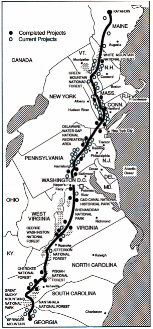
In 01988, the Appalachian Trail was twenty-one hundred thirty four point three miles long. As it is a living trail, this number varies from year to year when, in spring, several hundred people make their way to Springer Mtn, Georgia, to begin heading north. They are called northbounders and are the vast majority of thru-hikers on the Trail. Of these, only a few make it all the way to Mt Katahdin in Maine, the northern terminus of the Trail.
Its been over twelve years since DŁg Fresh thru-hiked the Appalachian Trail. If, as they say, every seven years or so every cell in the body is replaced, then, at least physiologically speaking, he is not the same person who hiked the Trail those many years ago. Yet, there is that which remains.
He has long wanted to tell the "thousand and one tales" of this amazing journey. But to find a single unifying thread and follow it to some satisfying conclusion, that has ever eluded him. There always seemed to be too much of everything in there to expose more than some massive Gordian Knot.
Like every previous attempt, there seemed to be an infinite regress, a ring pass not, which first needed to be somehow overcome. In the past he tried to solve this conundrum with attempted explanations and rationalizations as to how and why he found himself in Georgia in the spring of 01988. Yet this led nowhere. Or rather, it led everywhere except to the point. It was like Xeno's Paradox. Before he could get to A he had to get to B and before he could get to B...and so on, ad infinitum. In hindsight, it has seemed easier to thru-hike the Appalachian Trail than to write about it.
So, he tried again; this time via a different route. This time, he simply tried to follow sage advice, to "go slow, go far," and hope that the tale would somehow tell itself. To see the entire journey before you, in the lens of the mind's eye, it can often seem far too daunting, too overwhelming even to begin. Yet, to take it one step at a time is to slowly and surely go far. After many years, he has finally learned to do here what he learned to do there.
What exactly is a 'thru-hiker'? Like all words their meaning comes from what we give them. Words are like cups and it is we who must fill them before they can hold value. In this case, 'thru-hiker' is just such a word. For some, the definition of a 'thru-hiker' is defined by those called 'Purists'. These Purists practically tap each white blaze they pass along the way. They get back on the Trail right where they leave off and they never, ever, skip anything. To the Purist, this is the strict definition of a 'thru-hiker'. However, while all Purists are thru-hikers, not all thru-hikers are Purists. Some will 'blue-blaze' it into town, finding alternate routes back onto the trail. Others will 'flip flop' at first sign of fall and hike south from Katahdin, filling in the gaps sometimes years later. Still others may take several years, hiking only a little at a time. Indeed, the majority of thru-hikers in 01988 who made it all the way to Katahdin were of a wide variety of colors, shapes and sizes. Some were called SandBaggers; others, BushPigs or Great Descenders. They were all pure in spirit, if not necessarily in the minds of others. These thru-hikers were a vast assortment of characters who had less to do with rules and definitions and more to do with something which has no immediate expression in language. Often, their Trail Names were all the description you'd get. There was Steve - n - Jerry, who proudly raised the flag of Jerry Garcia wherever he went. There were the "singing" Stars - Wandering Star, Lucky Star, and Shining Star - who could out-sing the Whippoorwills into the wee hours of the morning. There were the Great Descenders who brought and read a small library of Manhattan's vintage press along the way. There were the Smokestacks who would take time out from smoking just to hike the Trail. And this was their second time!
Among this strange and diverse company, DŁg came to be known as The Agnostic Monk. For him, his definition of a thru-hiker was suitably broad and all-encompassing: thru-hikers are long-distance hikers who travel more or less continuously for long periods of time. It doesn't matter if they reach Katahdin (or, in the case of the few southbounders, Springer), or if they walk a mile, turn around, walk back and repeat that again and again for several months. It doesn't even matter if it is an Appalachian Trail, a Continental Divide Trail or an International Peace Trail. It only matters that they meet the Trail in their own way. For the Agnostic Monk, his thru-hike lasted approximately 160 days or roughly six months and two days. But while his journey began atop Springer Mountain on April 6th and ended atop Mount Katahdin on October 8th, of the 2134.3 miles of the Appalachian Trail, he only hiked about 1822.1 of them that year. He skipped New Jersey, New York, Connecticut and Massachusetts. Why? The long story is but one of the Thousand and One Tales contained herein. The short story was that he was broke, both figuratively and literally. He was out of money and had blown out his boots on the sharp Pennsylvanian rocks, just like The Philosopher's Guide said he would. He needed to regroup.
When he started off on the Trail he set no expectations. He was only going to see how far he could go. It was something of a surprise that he even made it out of Georgia at all, let alone all the way to Pennsylvania. Having never in his life done anything like this before, he did not foist upon his journey any expectations. However, he exceeded far more than any expectations he could have had, he exceeded his resources as well.
So DŁg returned home to Albany, NY, for 27 days of much needed rest and recuperation. There were many reasons why he did not get back on where he had gotten off. Part of him rebelled against the idea that he should hike his hike in accordance with someone else's criteria. He fundamentally disagreed with any concept of purism that contradicted something ineffable deep within. But the bottom line was that he knew he might not make it all the way to Mt Katahdin, before it closed for the season, if he did not skip ahead to Vermont and return to the Trail from there.
Thus, for some, there may be a question as to whether DŁg was or was not a thru-hiker. Certainly from the Purist point of view he was not. But that is not important. What matters is that, as corny as it may sound, to himself he was true. Was he a thru-hiker? By his own definition, yes. He most certainly was.
However, what really matters is that, to this day, his journey along the Appalachian Trail has been the single most important and meaningful event in his life, after birth. What matters is that he achieved and accomplished something truly wonderful, something which far exceeded anything he had thought himself capable of accomplishing before.
But, the most amazing thing, the absolute synchronicity of it all, was that the very last person he said goodbye to at the Presbyterian Church Hostel, in Delaware Water Gap, was Ken Bushpig and, after getting back on the Trail, the very first person he ran into, at the Melville Nauhein Shelter, was Ken Bushpig! That, to him, said it all.

Getting to the Point
On April 1st, 01988, Airman Page was honorably discharged from the United States Air Force. On April 3rd, he said good-bye to the people he knew in San Antonio, Texas, and boarded a bus for Georgia. He arrived in Atlanta on the 5th.
 About three months prior, a Two Star General from the Pentagon had flown in to Lackland AFB, where Airman Page was stationed. The General quickly broke the entire base up into groups and fed them into Lackland's Main Auditorium for several sold out performances. Inside, he spoke of budget cuts and hi-tech gadgetry, the cost of planes that can think and read minds and the cost of people to fly and maintain them. The bottom line was that the Air Force was running a little short on cash. It was offering an early out, to anyone who was not going to re-enlist, so that the Generals could spend their money on other things. This turned out to be of divine providence as, at right about the same time, two events occurred in quick succession which were to combine with this to have a deep and lasting impact on the future course and direction of young Airman Page's life. The first was that a friend, John Reschovski, had sent him a manuscript documenting John's journey along New York's Northville-Lake Placid Trail. Airman Page found this very inspirational. Then, almost simultaneously, synchronicity conspired to bring to his attention an article in National Geographic about a trail he had never heard of before, the Appalachian Trail. It was as if he had just been given a message from the Cosmic Coincidence Control Center and he had heard it loud and clear. Never let it be said he could not put one and two together and get four. So he accepted the offer for early release and began making plans to hike the Appalachian Trail. He was given a choice of any day in April. He chose the first.
About three months prior, a Two Star General from the Pentagon had flown in to Lackland AFB, where Airman Page was stationed. The General quickly broke the entire base up into groups and fed them into Lackland's Main Auditorium for several sold out performances. Inside, he spoke of budget cuts and hi-tech gadgetry, the cost of planes that can think and read minds and the cost of people to fly and maintain them. The bottom line was that the Air Force was running a little short on cash. It was offering an early out, to anyone who was not going to re-enlist, so that the Generals could spend their money on other things. This turned out to be of divine providence as, at right about the same time, two events occurred in quick succession which were to combine with this to have a deep and lasting impact on the future course and direction of young Airman Page's life. The first was that a friend, John Reschovski, had sent him a manuscript documenting John's journey along New York's Northville-Lake Placid Trail. Airman Page found this very inspirational. Then, almost simultaneously, synchronicity conspired to bring to his attention an article in National Geographic about a trail he had never heard of before, the Appalachian Trail. It was as if he had just been given a message from the Cosmic Coincidence Control Center and he had heard it loud and clear. Never let it be said he could not put one and two together and get four. So he accepted the offer for early release and began making plans to hike the Appalachian Trail. He was given a choice of any day in April. He chose the first.
He then began preparing to hike the "app-illusion trail" as Staff Sergeant Holcombe, a co-worker, called it. He put in a huge order with Campmor, purchasing new equipment. Then he purchased four Guide Books, North-Carolina-Georgia, Tennessee-North Carolina, New Hampshire-Vermont, and Maine; the Philosopher's Guide, which he didn't receive until Neels Gap due to printing problems; and the Appalachian Data Book from the ATC. By far the most important book was the Data Book. This detailed the distances between shelters and Trail towns, mountain springs and road crossings. With it Airman Page plotted out a rough itinerary, and mailed himself Food Drops all the way to Mt Washington, NH. For a laugh, try to imagine the looks on their faces at the Post Office on Mt Washington when, five months later, he showed up for his package. It was like they just saw a ghost.
In the bus station in Atlanta, Freeman Page propitiously bumped into Harold Poole. The moment Harold saw Page's Pack he bounced over like a rubber ball and asked Page if he was hiking the Appalachian Trail too. Page introduced himself as DŁg and said yes. Meeting Harold was very fortuitous as DŁg had only been able to make arrangements as far as Gainesville. Harold on the other hand, had already arranged to have a driver from the Appalachian Adventures Shuttle Service meet him at Gainesville. Sure enough, when they arrived at Gainesville, they were greeted by Steve Hicks, their shuttle driver. DŁg and Harold were so excited that they barely even noticed a lone hiker getting back on the bus and heading home. This was their first warning that thru-hikers do not grow on trees, that not everyone makes it all the way to Mt. Katahdin. It slipped quietly by under the radar. They were far too excited to stop and reconsider. They quickly loaded up and headed out.
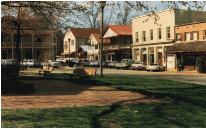
They say, many of the people who start the Appalachian Trail at Amicalola Falls, never make it to Springer Mtn. The story goes, the trail to Springer is paved with gear - tossed off by those trying to lighten their load in a last ditch effort to reach the start of the Trail. At least that was the gist of the horror story as was painted by Steve, their shuttle driver. It worked powerful mojo on Harold who looked suddenly deflated. So Steve convinced Harold that he should take them instead to Nimblewell Gap, a mere 2.5 miles from the summit of Springer. Instantly, the bounce in Harold's cheeks returned. In retrospect this was extremely good fortune, akin to being given both a running start and a kick in the pants. And, as the trail did not begin at Amicalola Falls, there was no harm done.
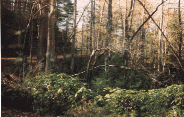
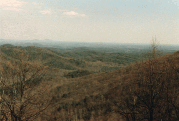
Along the way they were afforded excellent views of the Chattahoochee National Forest through which they would soon be hiking. Steve took good care of them. He warned them that they would be heading into areas in which help would not be easily accessible. He was concerned about DŁg's pack weight which, even after removing several pounds still clocked in at over 72 pounds.
DŁg's pack weight, coupled with the fact that he hadn't had any sleep since he left San Antonio the day before yesterday, made him look as though he was going to topple over at any minute. In stark contrast, Harold look the very model of unbridled enthusiasm, as if he could bounce all the way to Maine.
Pack weight can be a major factor in any robust definition of a thru-hiker. Overloaded packs are quite often a common error for those just starting out. They say pack weight should not be more than a third of your body weight. For DŁg, this should have been around 65 pounds. However, he found that even this is far too weighty for any serious long distance hiking. At his first opportunity, he got off the trail (at Woody Gap, where he met Beth and Chandra for the first time), and hitch-hiked into Suches, Georgia. At the Post Office, he mailed home his Timberline Eureka with Vestibule and about 5-10 pounds of other miscellaneous items. After being near crushed to death beneath the weight, he felt a thousand times better. But this was only the first of three major tribulations which threatened to end his journey right there in Georgia. The other two were Blood Mountain.
DŁg found, as he continued to progress along the Trail, that his ideal pack weight was about 35 pounds, without food or tent (or beer). Generally, depending on the proximity of the next Post Office, he carried about 5-10 days worth of food. This averaged out to about 10-15 pounds. But, often that included beer, which was considered a major source of fuel among the Bushpigs and Sandbaggers, who called it Carbo-loading.
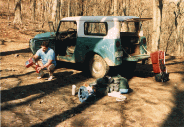
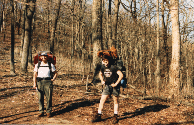
Harold and DŁg thanked Steve and said good bye. From Nimblewell Gap they began their ascent up Black Mtn. This stood between them and Springer. They descended into the gap in the late afternoon and made it to the summit of Springer Mtn (3,782 ft) near sunset. They were just in time for the last rays of sunshine to fall upon the plaque which greets all visitors and which marks the southern terminus of the Trail. For northbounders, this is the start of the Appalachian Trail. As it was almost dark, they did not linger long and instead made their way to Springer Mtn Shelter for the evening.
©Copyright 09/04/02000. Fresh Ink. All rights reserved
Return to the International Peace Trail

Appalachian Trail Council Home Page